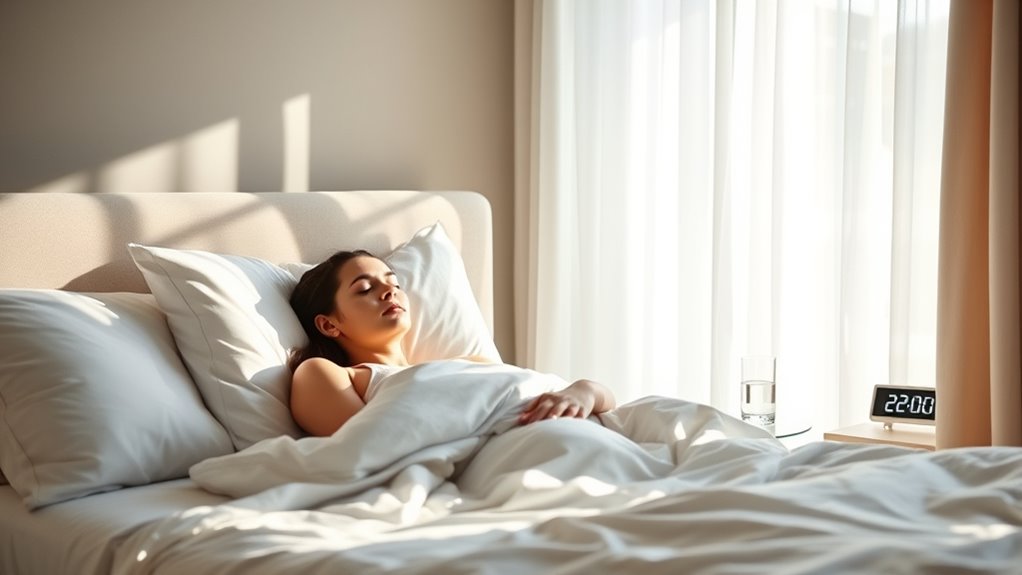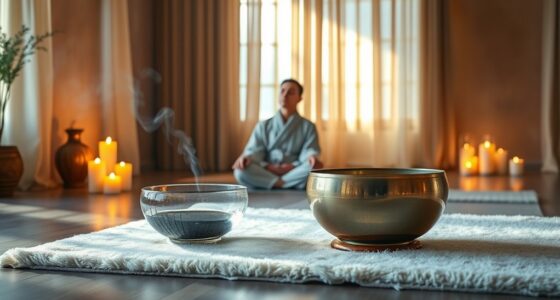A 20-minute power nap is ideal because it targets light sleep stages, helping you recharge without entering deep sleep, which can cause grogginess. Short naps boost alertness, energy, and cognitive function while minimizing sleep inertia. Staying within this duration keeps you in lighter sleep, making you feel refreshed quickly. If you want to learn more about how timing and sleep cycles enhance your rest, keep exploring these insights.
Key Takeaways
- A 20-minute nap aligns with light sleep stages, preventing deep sleep and minimizing grogginess.
- Limiting naps to 20 minutes avoids entering slow-wave sleep, ensuring quick, restorative energy boosts.
- Short naps enhance alertness, cognitive function, and mood without disrupting nighttime sleep patterns.
- The 20-minute duration is based on the typical sleep cycle, maximizing restorative benefits efficiently.
- Consistent power napping during midday optimizes alertness and supports overall productivity.

Have you ever wondered how a quick nap can boost your productivity and alertness? It turns out, the secret lies in understanding your sleep cycle and the ideal napping duration. When you rest, your body goes through a series of sleep stages, collectively called a sleep cycle, which typically lasts about 90 minutes. During this cycle, you shift from light sleep to deep sleep and then to REM sleep. When you nap for too long, especially beyond 20 minutes, you risk entering the deeper stages of sleep, making it harder to wake up feeling refreshed and alert. That’s why the duration of your nap matters so much if you want to harness its benefits without feeling groggy afterward.
A power nap, specifically lasting around 20 minutes, is designed to tap into the lighter stages of sleep, primarily stage 1 and stage 2. These stages are where your brain winds down, but you haven’t yet entered the deep sleep phase. By limiting your nap to this window, you avoid the sluggishness that often accompanies waking from deep sleep. This duration aligns well with your sleep cycle, allowing you to wake up feeling energized and ready to tackle your tasks without the grogginess known as sleep inertia.
The key to making the most of a power nap is timing. Since your sleep cycle lasts roughly 90 minutes, a nap of about 20 minutes keeps you in the light sleep zones. If you extend your nap beyond this, say to 30 or 40 minutes, you risk slipping into deeper sleep stages. Waking up from those stages can leave you feeling disoriented and even more tired than before. That’s why sticking to a 20-minute window is ideal—it’s long enough to give your brain a quick recharge but short enough to prevent entering the deep sleep phases that would sabotage your alertness.
Another vital aspect is consistency. Incorporating short naps into your daily routine at the same time each day helps your body anticipate and adapt to this rest period, maximizing its restorative effects. Whether you’re taking a quick break at work or catching a midday rest at home, maintaining the right napping duration ensures you reap the full benefits of this science-backed practice. Additionally, understanding the impact of natural language processing (NLP) on customer experience can help businesses tailor their services to better support employee well-being. By understanding your sleep cycle and keeping your nap within the ideal 20-minute window, you give yourself a powerful tool to boost your focus, mood, and overall productivity without disrupting your nighttime sleep.
Frequently Asked Questions
Can Power Naps Replace a Full Night’S Sleep?
Power naps can’t replace a full night’s sleep, especially if you’re sleep-deprived. While short naps of about 20 minutes boost alertness and reduce fatigue, they don’t provide all the benefits of a complete sleep cycle, like memory consolidation and physical restoration. Relying solely on naps may help temporarily, but for long-term health, consistent full-night sleep is essential. So, don’t skip your regular sleep in favor of just naps.
How Does Caffeine Affect Power Nap Effectiveness?
Caffeine interaction can boost your power nap’s alertness enhancement, but timing matters. If you consume caffeine before napping, it may delay sleep onset or cause you to wake up groggy. Drinking caffeine after your nap can help sustain alertness, yet it might interfere with nighttime sleep. To maximize effectiveness, consider napping first, then enjoy caffeine afterward for a balanced alertness boost without disrupting rest.
Is There an Ideal Time of Day for Power Napping?
You might find that the best time for a power nap aligns with your circadian rhythms, typically early afternoon between 1-3 pm. During this window, your alertness dips, making nap timing more effective. Avoid napping too late, as it can interfere with nighttime sleep. By understanding your body’s natural rhythms, you can optimize nap timing for maximum refreshment and productivity throughout the day.
Are Power Naps Suitable for All Age Groups?
You might find it surprising, but power naps aren’t suitable for everyone, especially considering age considerations. While young adults often benefit, older adults or those with sleep disorders should approach napping cautiously. Children and teenagers generally need more rest, so short naps might help but shouldn’t replace regular sleep. Always listen to your body and consult a healthcare professional if sleep issues or disorders are a concern.
What Are the Long-Term Health Benefits of Regular Power Napping?
Regular power napping offers long-term health benefits like improved cognitive enhancement and better cardiovascular health. By taking short naps consistently, you boost your memory, focus, and mental clarity, which helps prevent cognitive decline. Plus, it reduces stress and lowers blood pressure, supporting your heart health. Incorporating power naps into your routine can lead to sustained energy, better mood, and overall well-being over time.
Conclusion
Now that you understand the science behind the perfect 20-minute power nap, imagine what you could access with just a quick break. Could this simple habit boost your focus, creativity, and energy when you need it most? The secret lies in timing and technique—but the real question is, are you ready to harness this hidden power? The next nap might just be your game-changer. Will you take that chance? The choice is yours.









